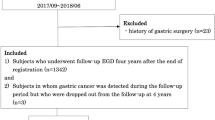Abstract
This study was carried out to develop a scoring system for the diagnosis of gastric adenocarcinoma (GAC). A total of 686 subjects, 150 patients with GAC, 182 with gastric ulcer, 127 with duodenal ulcer, and 227 subjects with negative findings, were enrolled. Analysis of the likelihood ratio (LR) showed that patients with advanced age, ulcer in the stomach, low serum levels of pepsinogen I (PGI), low PGI × gastrin values, and low PGI/gastrin ratio were likely to have GAC. Of these indicators, the serum PGI level had the greatest weight, with a LR of 7.59 for the group with a level <30 ng/ml. A scoring system combining serum PGI level,Helicobacter pylori seropositivity, and gastric ulcer status was derived, using a logistic regression model. This scoring system was found to be better than any one-parameter criterion for diagnosing GAC after evaluation by the area under the receiver operating characteristic curve (0.84; 95% confidence interval, 0.81–0.88) or by specificity-fixed sensitivity (sensitivity 0.82 at specificity 0.72, sensitivity 0.87 at specificity 0.66, sensitivity 0.96 at specificity 0.44). This scoring system may be potentially useful as a new model for the noninvasive diagnosis of GAC in the future.
Similar content being viewed by others
References
Parkin DM, Laara E, Muir CS. Estimates of the worldwide frequency of sixteen major cancers in 1980. Int J Cancer 1988; 41:184–197.
Dupont J, Lee J, Burton G, et al. Adenocarcinoma of the stomach: Review of 1497 cases. Cancer 1978;41:941–947.
Ellis DJ, Speirs C, Kingston RD et al. Carcinoembryonic antigen levels in advanced gastric carcinoma. Cancer 1978;42:623–625.
Ritts RE, Del Villano BC, Go VLW, et al. Initial clinical evaluation of an immunoradiometric assay for CA 19-9 using the NCI serum bank. Int J Cancer 1984;33:339–345.
Wobbes T, Thomas C, Segers M, Nagengast F. Evaluation of seven tumor markers (CA50, CA19-9, CA19-9 Truquant, CA72-4, CA195, carcinoembryonic antigen, and tissue polypeptide antigen) in the pretreatment sera of patients with gastric carcinoma. Cancer 1992;69:2036–2041.
Samloff IM, Varis K, Ihamäki T, et al. Relationships among serum pepsinogen I, serum pepsinogen II, and gastric mucosal histology: A study in relatives of patients with pernicious anemia. Gastroenterology 1982;83:204–209.
Varis K, Samloff IM, Ihamäki T, Siurala M. An appraisal of tests for severe atrophic gastritis in relatives of patients with pernicious anemia. Dig Dis Sci 1979;24:187–191.
Nomura A, Stemmerman GN, Samloff IM. Serum pepsinogen I as a predictor of stomach cancer. Ann Intern Med 1980;93:537–540.
Stemmermann GN, Samloff IM, Nomura A, Heilbrun LK. Serum pepsinogen I and II and stomach cancer. Clin Chim. Acta 1987;163:191–198.
Sipponen P, Valle J, Varis K, et al. Fasting levels of serum gastrin in different functional and morphological states of the antrofundal mucosa: An analysis of 860 subjects. Scand J Gastroenterol 1990;25:513–519.
McGuigan JE, Trudeau WKL. Serum and tissue gastrin concentrations in patients with carcinoma of the stomach. Gastroenterology 1973;64:22–25.
Farinati F, Mario F, Plebani M, et al. Pepsinogen A/pepsinogen C or pepsinogen A multiplied by gastrin in the diagnosis of gastric cancer. Ital J Gastroenterol 1991;223:194–196.
Parsonnet J, Friedman GD, Vandersteen DP, et al.Helicobacter pylori infeciton and the risk of gastric carcinoma. N Engl J Med 1991;325:1127–1131.
Nomura A, Stemmerman GN, Chyou P, et al.Helicobacter pylori infection and gastric carcinoma among Japanese Americans in Hawaii. N Engl J Med 1991;325:1132–1136.
Smith JTL, Pounder RE, Nwokole CU, et al. Inappropriate hypergastrinemia in asymptomatic healthy subjects withHelicobacter pylori. Gut 1990;31:522–525.
Asaka M, Kimura T, Kudo M, et al. Relationship ofHelicobacter pylori to serum pepsinogens in an asymptomatic Japanese population. Gastroenterology 1992;102:760–766.
Simel DL, Samsa GP, Matchar DB. Likelihood ratios for continuous test results: Making the clinician's job easier or harder? J Clin Epidemiol 1993;46:85–93.
Simel DL, Samsa GP, Matchar DB Likelihood ratios with confidence: Sample size estimation for diagnostic test studies. J Clin Epidemiol 1994;44:763–770.
SAS Technical Reoprt P-229, SAS/STAT software: LOGISTIC Procedures (release 6.07). Cary, NC, U.S.A., 1992.
Irwig L. Modelling result-specific likelihood ratios. J Clin Epidemiol 1992;45:1135–1140.
Hosmer DW, Lemeshow S. Goodness-of-fit tests for the multiple logistic regression model. Commun Statist Theor Meth 1980;A9(10):1043–1069.
Hanley JA, McNeil BJ. The meaning and use of the area under a receiver operating characteristic (ROC) curve. Radiology 1982;143:29–36.
DeLong ER, DeLong DM, Clarke-Pearson DL. Comparing the areas under two or more correlated receiver operating characteristic curves: A nonparametric approach. Biometrics 1988;44:837–845.
Beam CA, Wieand HS. A statistical method for the comparison of a discrete diagnostic test with several continuous diagnostic tests. Biometrics 1991;47:907–919.
Correa P. Is gastric carcinoma an infectious disease? N Engl J Med 1991;325:1170–1171.
Kuipers EJ, Gracia-Casanova M, Peña AS, et al.Helicobacter pylori serology in patients with gastric carcinoma. Scand J Gastroenterol 1993;28:433–437.
Sierra R, Muñoz N, Peña AS, et al. Antibodies toHelicobacter pylori and pepsinogen levels in children from Costa Rica: Comparison of two areas with different risks for stomach cancer. Cancer Epidemiol Biomark Prev 1992;1:449–454.
Lin JT, Wang JT, Wang TH, et al.Helicobacter pylori infection in a randomly selected population, healthy volunteers, and patients with gastric ulcer and gastric adenocarcinoma: A seroprevalence study in Taiwan. Scand J Gastroenterol 1993;28:1067–1072.
Lin JT, Wang JT, Wang TH, Wu MS, Chen CJ.Helicobacter pylori infection in early and advanced gastric adenocarcinoma: A seroprevalence study in 143. Taiwanese patients. Hepatogastroenterology 1993;40:596–599.
Kekki M, Samloff IM, Varis K, Ihamäki T. Serum pepsinogen I and serum gastrin in the screening of severe atrophic corpus gastritis. Scand J Gastroenterol 1991;26[Suppl 186]:109–116.
Cook EF, Goldman L. Empiric comparison of multivariate analytic techniques: Advantages and disadvantages of recursive partitioning analysis. J Chron Dis 1984;37:721–731.
Miki K, Ichinose M, Ishikawa KB, et al. Clinical application of serum pepsinogen I and II levels for mass screening to detect gastric cancer. Jpn J Cancer Res 1993;84:1086–1090.
Author information
Authors and Affiliations
Rights and permissions
About this article
Cite this article
Lin, JT., Lee, WC., Wu, MS. et al. Diagnosis of gastric adenocarcinoma using a scoring system: Combined assay of serological markers ofHelicobacter pylori infection, pepsinogen I and gastrin. J Gastroenterol 30, 156–161 (1995). https://doi.org/10.1007/BF02348659
Received:
Accepted:
Issue Date:
DOI: https://doi.org/10.1007/BF02348659




